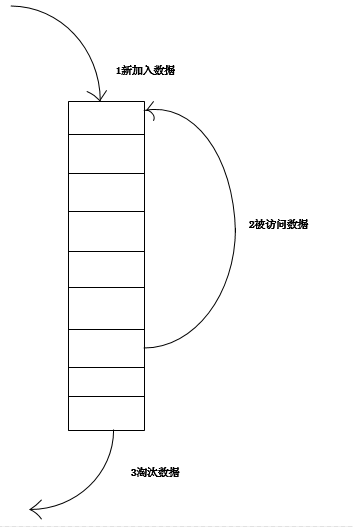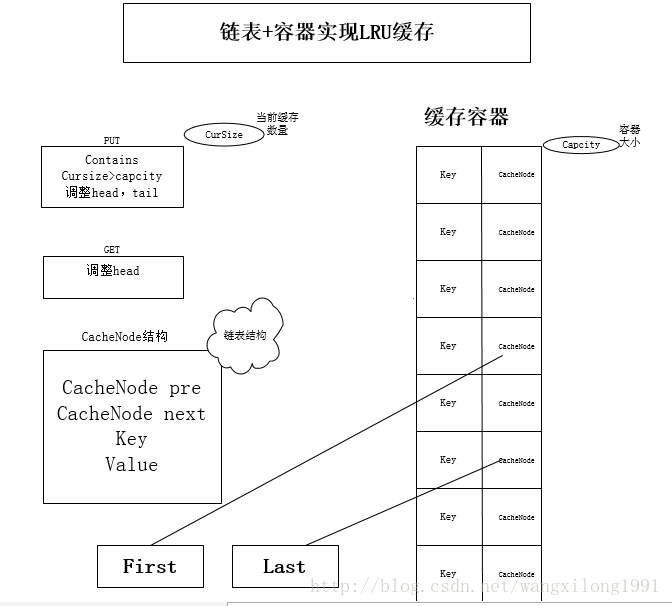精進之路之lru
阿新 • • 發佈:2018-11-11
原理
LRU(Least recently used,最近最少使用)演算法根據資料的歷史訪問記錄來進行淘汰資料,其核心思想是“如果資料最近被訪問過,那麼將來被訪問的機率也更高”。
實現1
最常見的實現是使用一個連結串列儲存快取資料,詳細演算法實現如下:

1. 新資料插入到連結串列頭部;
2. 每當快取命中(即快取資料被訪問),則將資料移到連結串列頭部;
3. 當連結串列滿的時候,將連結串列尾部的資料丟棄。
分析
【命中率】
當存在熱點資料時,LRU的效率很好,但偶發性的、週期性的批量操作會導致LRU命中率急劇下降,快取汙染情況比較嚴重。
【複雜度】
實現簡單。
【代價】
命中時需要遍歷連結串列,找到命中的資料塊索引,然後需要將資料移到頭部。
使用LinkedHashMap實現
LinkedHashMap底層就是用的HashMap加雙鏈表實現的,而且本身已經實現了按照訪問順序的儲存。此外,LinkedHashMap中本身就實現了一個方法removeEldestEntry用於判斷是否需要移除最不常讀取的數,方法預設是直接返回false,不會移除元素,所以需要重寫該方法。即當快取滿後就移除最不常用的數。
1 public class LRUCache<K, V> extends LinkedHashMap<K, V> { 2 3 privatestatic final long serialVersionUID = 1L; 4 5 //快取大小 6 private int cacheSize; 7 8 public LRUCache(int cacheSize) { 9 //第三個引數true是關鍵 10 super(10, 0.75f, true); 11 this.cacheSize = cacheSize; 12 } 13 14 /** 15 * 快取是否已滿 16 */ 17 @Override 18 protectedboolean removeEldestEntry(Map.Entry<K, V> eldest) { 19 boolean r = size() > cacheSize; 20 if (r) { 21 System.out.println("清除快取key:" + eldest.getKey()); 22 } 23 return r; 24 } 25 26 //測試 27 public static void main(String[] args) { 28 LRUCache<String, String> cache = new LRUCache<String, String>(5); 29 cache.put("1", "1"); 30 cache.put("2", "2"); 31 cache.put("3", "3"); 32 cache.put("4", "4"); 33 cache.put("5", "5"); 34 35 System.out.println("初始化:"); 36 System.out.println(cache.keySet()); 37 System.out.println("訪問3:"); 38 cache.get("3"); 39 System.out.println(cache.keySet()); 40 System.out.println("訪問2:"); 41 cache.get("2"); 42 System.out.println(cache.keySet()); 43 System.out.println("增加資料6,7:"); 44 cache.put("6", "6"); 45 cache.put("7", "7"); 46 System.out.println(cache.keySet()); 47 }
實現2
LRUCache的連結串列+HashMap實現

傳統意義的LRU演算法是為每一個Cache物件設定一個計數器,每次Cache命中則給計數器+1,而Cache用完,需要淘汰舊內容,放置新內容時,就檢視所有的計數器,並將最少使用的內容替換掉。
它的弊端很明顯,如果Cache的數量少,問題不會很大, 但是如果Cache的空間過大,達到10W或者100W以上,一旦需要淘汰,則需要遍歷所有計算器,其效能與資源消耗是巨大的。效率也就非常的慢了。
它的原理: 將Cache的所有位置都用雙連表連線起來,當一個位置被命中之後,就將通過調整連結串列的指向,將該位置調整到連結串列頭的位置,新加入的Cache直接加到連結串列頭中。
這樣,在多次進行Cache操作後,最近被命中的,就會被向連結串列頭方向移動,而沒有命中的,而想連結串列後面移動,連結串列尾則表示最近最少使用的Cache。
當需要替換內容時候,連結串列的最後位置就是最少被命中的位置,我們只需要淘汰連結串列最後的部分即可。
上面說了這麼多的理論, 下面用程式碼來實現一個LRU策略的快取。
非執行緒安全,若實現安全,則在響應的方法加鎖。
1 public class LRUCacheDemo<K, V> { 2 3 private int currentCacheSize; 4 private int CacheCapcity; 5 private HashMap<K, CacheNode> caches; 6 private CacheNode first; 7 private CacheNode last; 8 9 public LRUCacheDemo(int size) { 10 currentCacheSize = 0; 11 this.CacheCapcity = size; 12 caches = new HashMap<>(size); 13 } 14 15 public void put(K k, V v) { 16 CacheNode node = caches.get(k); 17 if (node == null) { 18 if (caches.size() >= CacheCapcity) { 19 caches.remove(last.key); 20 removeLast(); 21 } 22 node = new CacheNode(); 23 node.key = k; 24 } 25 node.value = v; 26 moveToFirst(node); 27 caches.put(k, node); 28 } 29 30 public Object get(K k) { 31 CacheNode node = caches.get(k); 32 if (node == null) { 33 return null; 34 } 35 moveToFirst(node); 36 return node.value; 37 } 38 39 public Object remove(K k) { 40 CacheNode node = caches.get(k); 41 if (node != null) { 42 if (node.pre != null) { 43 node.pre.next = node.next; 44 } 45 if (node.next != null) { 46 node.next.pre = node.pre; 47 } 48 if (node == first) { 49 first = node.next; 50 } 51 if (node == last) { 52 last = node.pre; 53 } 54 } 55 return caches.remove(k); 56 } 57 58 public void clear() { 59 first = null; 60 last = null; 61 caches.clear(); 62 } 63 64 private void moveToFirst(CacheNode node) { 65 if (first == node) { 66 return; 67 } 68 if (node.next != null) { 69 node.next.pre = node.pre; 70 } 71 if (node.pre != null) { 72 node.pre.next = node.next; 73 } 74 if (node == last) { 75 last = last.pre; 76 } 77 if (first == null || last == null) { 78 first = last = node; 79 return; 80 } 81 node.next = first; 82 first.pre = node; 83 first = node; 84 first.pre = null; 85 } 86 87 private void removeLast() { 88 if (last != null) { 89 last = last.pre; 90 if (last == null) { 91 first = null; 92 } else { 93 last.next = null; 94 } 95 } 96 } 97 98 @Override 99 public String toString() { 100 StringBuilder sb = new StringBuilder(); 101 CacheNode node = first; 102 while (node != null) { 103 sb.append(String.format("%s:%s ", node.key, node.value)); 104 node = node.next; 105 } 106 return sb.toString(); 107 } 108 109 class CacheNode { 110 CacheNode pre; 111 CacheNode next; 112 Object key; 113 Object value; 114 115 public CacheNode() { 116 } 117 } 118 119 public static void main(String[] args) { 120 LRUCache<Integer, String> lru = new LRUCache<Integer, String>(3); 121 lru.put(1, "a"); // 1:a 122 System.out.println(lru.toString()); 123 lru.put(2, "b"); // 2:b 1:a 124 System.out.println(lru.toString()); 125 lru.put(3, "c"); // 3:c 2:b 1:a 126 System.out.println(lru.toString()); 127 lru.put(4, "d"); // 4:d 3:c 2:b 128 System.out.println(lru.toString()); 129 lru.put(1, "aa"); // 1:aa 4:d 3:c 130 System.out.println(lru.toString()); 131 lru.put(2, "bb"); // 2:bb 1:aa 4:d 132 System.out.println(lru.toString()); 133 lru.put(5, "e"); // 5:e 2:bb 1:aa 134 System.out.println(lru.toString()); 135 lru.get(1); // 1:aa 5:e 2:bb 136 System.out.println(lru.toString()); 137 lru.remove(11); // 1:aa 5:e 2:bb 138 System.out.println(lru.toString()); 139 lru.remove(1); //5:e 2:bb 140 System.out.println(lru.toString()); 141 lru.put(1, "aaa"); //1:aaa 5:e 2:bb 142 System.out.println(lru.toString()); 143 } 144 }
本文參考整理於 https://blog.csdn.net/wangxilong1991/article/details/70172302 ,感謝原作者的精彩分享!!!
